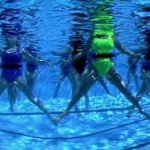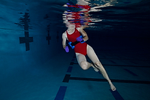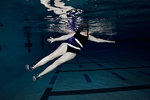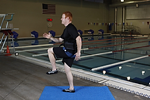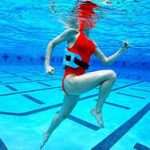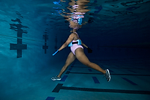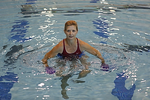My last 4 blog postings have been about building your exercise library. And if you are exercising in the pool on your own or teaching a water fitness class, it is important to build your exercise library. But how do you put it all together into a workout? You could just get in the pool and start doing whatever exercise comes to mind. Would there be a problem with doing the deep water exercises in the order of the pictures below?
The exercises are jumping jacks, jog with a diagonal lean, side to side extension, knee high jog, lateral flexion, power run, cross-country ski, and jog with elevation. All of these are good exercises, but would you want to do them in this order? Of course not! But why not? You would be asking your body to jump right into cardio, drop down into core work, go back into cardio, stretch, go into high intensity cardio, and then you’re done.
It would be much better for your body to give it time to work up to higher intensities and then let it come down gradually. That’s why a good workout has 4 distinctive parts:
- The warm up. When you first get into the pool, the water feels cold. That’s because the pool temperature is perhaps 15 degrees cooler than body temperature. You need to acclimate to the environment of the water, warm up the muscles, and increase the metabolic rate in order to be ready for your workout. Start with a vigorous short-lever exercise, such as a knee-high jog. Then add long lever exercises, such as a jumping jack. The warm-up should last from 5-10 minutes.
- The conditioning phase. This is the main part of your workout. If your goal is cardiorespiratory endurance, then you want to do exercises that get your heart rate up. Cross-country ski is the perfect exercise for this! You can also increase intensity by adding acceleration, (as in the power run) or elevation. Your conditioning phase lasts 20-50 minutes, depending on how long your want your workout to be or how long your class is.
- The cool down. You need your heart rate to return to its resting state. So you will start to slow down by using lower intensity exercises. The jog with a diagonal lean is a good transitional exercise. It is less vigorous than a power run and it adds in a core challenge to maintain alignment. When the heart rate has come down, you can do toning exercises or core exercises, such as the side to side extension. The cool down lasts 5-15 minutes.
- The post stretch. The best time to work on flexibility is now, when the muscles are still warm. Lengthen a muscle and then hold it in a static stretch. Or move the joints through their full range of motion in a dynamic stretch. Aim to stretch for at least 5 minutes.
It may take some planning to put together a workout that is not just a random set of exercises, but your body will thank you. I’ll bet you can rearrange those pictures above into a better order now.

See you in the pool!
Chris Alexander
For more information about organizing workouts, see my book, Water Fitness Lesson Plans and Choreography. You can find out how to order it on my website at www.waterfitnesslessons.com

